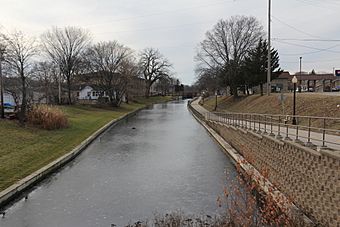Portage Canal facts for kids
- For the Portage Canal located in the Keweenaw Peninsula, see Keweenaw Waterway.
Quick facts for kids |
|
|
Portage Canal
|
|

Portage Canal in downtown Portage
|
|
| Location | Between the Fox and Wisconsin Rivers, Portage, WI |
|---|---|
| Built | 1835 |
| Architect | Conro, Starke & Co.; U.S.Army Corps of Engineers |
| NRHP reference No. | 77000030 |
| Added to NRHP | August 26, 1977 |
The Portage Canal was a special waterway built in Portage, Wisconsin. Its main job was to connect two important rivers: the Fox River and the Wisconsin River. This connection was part of a bigger water route called the Fox–Wisconsin Waterway.
For a while, the Portage Canal helped create an amazing water path. You could travel all the way from the north Atlantic Ocean, through the St. Lawrence Seaway, down the Mississippi River to the Gulf of Mexico, and then back to the Atlantic! It was a huge deal for travel and trade.
Contents
Building the Portage Canal
Building the Portage Canal was a very tough job. The land between the Fox and Wisconsin rivers was marshy and muddy. People tried many times to dig this important connection.
Early Attempts
The first try began in 1837. A group called the Portage Canal Company started digging. Workers had to dig and haul dirt by hand for two and a half miles through thick mud. This project was too difficult and was soon given up.
Another attempt started in 1849. This time, they managed to dig a path that canoes could use. However, it wasn't wide or deep enough for larger boats needed for trade. So, it wasn't very useful for business.
Final Completion
The final and successful project began later. It included building special structures called locks. Locks are like water elevators that raise or lower boats between different water levels. These locks were needed to make the Fox River's water level match the Wisconsin River's.
The Army Corps of Engineers finished this big project in 1876. But by then, new ways of travel were becoming popular. Railroads were quickly built across the country, and soon after, cars and trucks arrived. This meant the canal's time as a major trade route was short.
Upgrades and Repairs
The Portage Canal needed repairs and upgrades over the years to keep it working.
The 1926 Lock Upgrade
In April 1926, the old wooden gate and part of the lock from 1876 broke. To fix this, the canal got a brand new steel gate and a concrete lock. This was a big improvement!
A company from Chicago, M.E. White Company, won the job in August 1926. They worked under the watchful eye of the U.S. Army Corps of Engineers. The new 1926 Portage Canal Lock was special because it was the first one on the Fox River to use steel and concrete.
Challenges During Construction
Building the new lock wasn't easy. The engineers faced a big problem: underground springs kept bubbling up beneath the lock. This caused many delays. The White Construction Company had to repair fallen walls and rebuild parts of the lock. They used a huge amount of cement, about 9,000 barrels, to make the new strong structures. The new canal lock and gate were finally finished in May 1928.
Life of the Canal
The Portage Canal was a busy place for a few decades, but its main use changed over time.
Decline in Use
The canal was a major way to move goods for only a few decades. After that, pleasure boats, like steamboats, still used the narrow waterway for fun. However, because it wasn't used for trade as much, the canal slowly started to fall apart. It wasn't kept up very well.
The canal was used until 1951. At that time, one of its locks, the Fort Winnebago Lock, was bulldozed (pushed down). The locks connecting to the Wisconsin River were also permanently closed.
Current Efforts
Today, water pumps are the main way water flows through the canal. These pumps also help add air to the water, which is important for the canal's health.
Many people are trying to restore the canal to its original condition. The Portage Canal Society works hard to raise money and make improvements. In 2015, work began on the eastern part of the canal in downtown Portage. New government offices were planned to be built there and opened in 2017.



